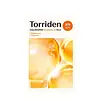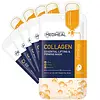What's inside
What's inside
 Key Ingredients
Key Ingredients

 Benefits
Benefits

 Concerns
Concerns

No concerns
 Ingredients Side-by-side
Ingredients Side-by-side

Water
Skin ConditioningGlycerin
HumectantButylene Glycol
HumectantNiacinamide
Smoothing1,2-Hexanediol
Skin ConditioningGlycereth-26
HumectantPanthenol
Skin Conditioning3-O-Ethyl Ascorbic Acid
Skin ConditioningAdenosine
Skin ConditioningAllantoin
Skin ConditioningTocopherol
AntioxidantGlutathione
Ascorbyl Glucoside
AntioxidantAscorbyl Palmitate
AntioxidantAscorbic Acid
AntioxidantAscorbyl Tetraisopalmitate
AntioxidantTripeptide-1
Skin ConditioningHydrolyzed Hyaluronic Acid
HumectantCeramide NP
Skin ConditioningCaprylic/Capric Triglyceride
MaskingOctyldodecanol
EmollientC14-22 Alcohols
Emulsion StabilisingAcrylates/C10-30 Alkyl Acrylate Crosspolymer
Emulsion StabilisingEthylhexylglycerin
Skin ConditioningSodium Acetylated Hyaluronate
HumectantSodium Hyaluronate
HumectantSodium Hyaluronate Crosspolymer
HumectantTromethamine
BufferingGlyceryl Acrylate/Acrylic Acid Copolymer
HumectantC12-20 Alkyl Glucoside
EmulsifyingPvm/Ma Copolymer
Emulsion StabilisingHydrogenated Lecithin
EmulsifyingDisodium EDTA
Polyglyceryl-10 Myristate
Skin ConditioningPentylene Glycol
Skin ConditioningIsopentyldiol
Humectant2,3-Butanediol
HumectantHydrolyzed Sodium Hyaluronate
Skin ConditioningPolyglyceryl-4 Oleate
EmulsifyingSodium Stearoyl Glutamate
CleansingArginine
MaskingCarbomer
Emulsion StabilisingProline
Skin ConditioningGlucose
HumectantXanthan Gum
EmulsifyingWater, Glycerin, Butylene Glycol, Niacinamide, 1,2-Hexanediol, Glycereth-26, Panthenol, 3-O-Ethyl Ascorbic Acid, Adenosine, Allantoin, Tocopherol, Glutathione, Ascorbyl Glucoside, Ascorbyl Palmitate, Ascorbic Acid, Ascorbyl Tetraisopalmitate, Tripeptide-1, Hydrolyzed Hyaluronic Acid, Ceramide NP, Caprylic/Capric Triglyceride, Octyldodecanol, C14-22 Alcohols, Acrylates/C10-30 Alkyl Acrylate Crosspolymer, Ethylhexylglycerin, Sodium Acetylated Hyaluronate, Sodium Hyaluronate, Sodium Hyaluronate Crosspolymer, Tromethamine, Glyceryl Acrylate/Acrylic Acid Copolymer, C12-20 Alkyl Glucoside, Pvm/Ma Copolymer, Hydrogenated Lecithin, Disodium EDTA, Polyglyceryl-10 Myristate, Pentylene Glycol, Isopentyldiol, 2,3-Butanediol, Hydrolyzed Sodium Hyaluronate, Polyglyceryl-4 Oleate, Sodium Stearoyl Glutamate, Arginine, Carbomer, Proline, Glucose, Xanthan Gum
Water
Skin ConditioningGlycerin
HumectantPropanediol
Solvent1,2-Hexanediol
Skin ConditioningSalix Alba Bark Extract
AstringentButylene Glycol
HumectantXanthan Gum
EmulsifyingHydrolyzed Collagen
EmollientPolysorbate 80
EmulsifyingPanthenol
Skin ConditioningTrehalose
HumectantBetaine
HumectantCarbomer
Emulsion StabilisingArginine
MaskingAllantoin
Skin ConditioningDisodium EDTA
Boswellia Serrata Resin Extract
SmoothingHydrolyzed Elastin
EmollientTocopheryl Acetate
AntioxidantSodium Hyaluronate
HumectantSodium Ascorbyl Phosphate
AntioxidantWheat Amino Acids
Skin ConditioningDipotassium Glycyrrhizate
HumectantEthylhexylglycerin
Skin ConditioningPortulaca Oleracea Extract
Skin ConditioningAcetyl Hexapeptide-8
HumectantAloe Barbadensis Leaf Juice
Skin ConditioningBeta-Glucan
Skin ConditioningParfum
MaskingWater, Glycerin, Propanediol, 1,2-Hexanediol, Salix Alba Bark Extract, Butylene Glycol, Xanthan Gum, Hydrolyzed Collagen, Polysorbate 80, Panthenol, Trehalose, Betaine, Carbomer, Arginine, Allantoin, Disodium EDTA, Boswellia Serrata Resin Extract, Hydrolyzed Elastin, Tocopheryl Acetate, Sodium Hyaluronate, Sodium Ascorbyl Phosphate, Wheat Amino Acids, Dipotassium Glycyrrhizate, Ethylhexylglycerin, Portulaca Oleracea Extract, Acetyl Hexapeptide-8, Aloe Barbadensis Leaf Juice, Beta-Glucan, Parfum
 Reviews
Reviews

Ingredients Explained
These ingredients are found in both products.
Ingredients higher up in an ingredient list are typically present in a larger amount.
1,2-Hexanediol is a synthetic liquid and another multi-functional powerhouse.
It is a:
- Humectant, drawing moisture into the skin
- Emollient, helping to soften skin
- Solvent, dispersing and stabilizing formulas
- Preservative booster, enhancing the antimicrobial activity of other preservatives
Allantoin is a soothing ingredient known for its protective and moisturizingg properties. Because of this, it is often added to products with strong active ingredients.
Studies show higher concentrations of this ingredient can promote wound healing.
Though it can be derived from the comfrey plant, allantoin is produced synthetically for cosmetic products to ensure purity.
Learn more about AllantoinArginine is an amino acid that is important for human development. Your body uses is it to produce hair keratin and skin collagen.
As a cosmetic ingredient, Arginine has antioxidant properties and can also help repair damaged skin. This ingredient is derived either synthetically or from animals.
Arginine isn't fungal acne safe when used in the presence of other lipids (fats, fatty acids, oils, esters, etc). Oils and fats occur naturally within the skin, so take caution when using Arginine if you're prone to fungal acne.
Learn more about ArginineButylene Glycol (or BG) is used within cosmetic products for a few different reasons:
Overall, Butylene Glycol is a safe and well-rounded ingredient that works well with other ingredients.
Though this ingredient works well with most skin types, some people with sensitive skin may experience a reaction such as allergic rashes, closed comedones, or itchiness.
Learn more about Butylene GlycolCarbomer is a polymer of acrylic acid. Its main role is to create a gel consistency.
A high amount of carbomer can cause pilling or balling up of products. Don't worry, most products contain 1% or less of carbomer.
Disodium EDTA plays a role in making products more stable by aiding other preservatives.
It is a chelating agent, meaning it neutralizes metal ions that may be found in a product.
Disodium EDTA is a salt of edetic acid and is found to be safe in cosmetic ingredients.
Learn more about Disodium EDTAEthylhexylglycerin (we can't pronounce this either) is commonly used as a preservative and skin softener. It is derived from glyceryl.
You might see Ethylhexylglycerin often paired with other preservatives such as phenoxyethanol. Ethylhexylglycerin has been found to increase the effectiveness of these other preservatives.
Glycerin is already naturally found in your skin. It helps moisturize and protect your skin.
A study from 2016 found glycerin to be more effective as a humectant than AHAs and hyaluronic acid.
As a humectant, it helps the skin stay hydrated by pulling moisture to your skin. The low molecular weight of glycerin allows it to pull moisture into the deeper layers of your skin.
Hydrated skin improves your skin barrier; Your skin barrier helps protect against irritants and bacteria.
Glycerin has also been found to have antimicrobial and antiviral properties. Due to these properties, glycerin is often used in wound and burn treatments.
In cosmetics, glycerin is usually derived from plants such as soybean or palm. However, it can also be sourced from animals, such as tallow or animal fat.
This ingredient is organic, colorless, odorless, and non-toxic.
Glycerin is the name for this ingredient in American English. British English uses Glycerol/Glycerine.
Learn more about GlycerinPanthenol is a common ingredient that helps hydrate and soothe the skin. It is found naturally in our skin and hair.
There are two forms of panthenol: D and L.
D-panthenol is also known as dexpanthenol. Most cosmetics use dexpanthenol or a mixture of D and L-panthenol.
Panthenol is famous due to its ability to go deeper into the skin's layers. Using this ingredient has numerous pros (and no cons):
Like hyaluronic acid, panthenol is a humectant. Humectants are able to bind and hold large amounts of water to keep skin hydrated.
This ingredient works well for wound healing. It works by increasing tissue in the wound and helps close open wounds.
Once oxidized, panthenol converts to pantothenic acid. Panthothenic acid is found in all living cells.
This ingredient is also referred to as pro-vitamin B5.
Learn more about PanthenolSodium Hyaluronate is hyaluronic acid's salt form. It is commonly derived from the sodium salt of hyaluronic acid.
Like hyaluronic acid, it is great at holding water and acts as a humectant. This makes it a great skin hydrating ingredient.
Sodium Hyaluronate is naturally occurring in our bodies and is mostly found in eye fluid and joints.
These are some other common types of Hyaluronic Acid:
Learn more about Sodium HyaluronateWater. It's the most common cosmetic ingredient of all. You'll usually see it at the top of ingredient lists, meaning that it makes up the largest part of the product.
So why is it so popular? Water most often acts as a solvent - this means that it helps dissolve other ingredients into the formulation.
You'll also recognize water as that liquid we all need to stay alive. If you see this, drink a glass of water. Stay hydrated!
Learn more about WaterXanthan gum is used as a stabilizer and thickener within cosmetic products. It helps give products a sticky, thick feeling - preventing them from being too runny.
On the technical side of things, xanthan gum is a polysaccharide - a combination consisting of multiple sugar molecules bonded together.
Xanthan gum is a pretty common and great ingredient. It is a natural, non-toxic, non-irritating ingredient that is also commonly used in food products.
Learn more about Xanthan Gum